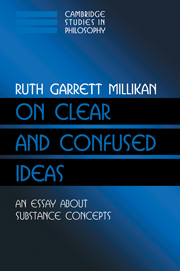Book contents
- Frontmatter
- Contents
- Preface
- Chapter 1 Introducing Substance Concepts
- Chapter 2 Substances: The Ontology
- Chapter 3 Classifying, Identifying, and the Function of Substance Concepts
- Chapter 4 The Nature of Abilities: How Is Extension Determined?
- Chapter 5 More Mama, More Milk and More Mouse: The Structure and Development of Substance Concepts
- Chapter 6 Substance Concepts Through Language: Knowing the Meanings of Words
- Chapter 7 How We Make Our Ideas Clear: Epistemology for Empirical Concepts
- Chapter 8 Content and Vehicle in Perception
- Chapter 9 Sames Versus Sameness in Conceptual Contents and Vehicles
- Chapter 10 Grasping Sameness
- Chapter 11 In Search of Strawsonian Modes of Presentation
- Chapter 12 Rejecting Identity Judgments and Fregean Modes
- Chapter 13 Knowing What I'm Thinking Of
- Chapter 14 How Extensions of New Substance Concepts are Fixed: How Substance Concepts Acquire Intentionality
- Chapter 15 Cognitive Luck: Substance Concepts in an Evolutionary Frame
- Appendix A Contrast with Evans on Information-Based Thoughts
- Appendix B What Has Natural Information to Do with Intentional Representation?
- References
- Index
Chapter 15 - Cognitive Luck: Substance Concepts in an Evolutionary Frame
Published online by Cambridge University Press: 02 December 2009
- Frontmatter
- Contents
- Preface
- Chapter 1 Introducing Substance Concepts
- Chapter 2 Substances: The Ontology
- Chapter 3 Classifying, Identifying, and the Function of Substance Concepts
- Chapter 4 The Nature of Abilities: How Is Extension Determined?
- Chapter 5 More Mama, More Milk and More Mouse: The Structure and Development of Substance Concepts
- Chapter 6 Substance Concepts Through Language: Knowing the Meanings of Words
- Chapter 7 How We Make Our Ideas Clear: Epistemology for Empirical Concepts
- Chapter 8 Content and Vehicle in Perception
- Chapter 9 Sames Versus Sameness in Conceptual Contents and Vehicles
- Chapter 10 Grasping Sameness
- Chapter 11 In Search of Strawsonian Modes of Presentation
- Chapter 12 Rejecting Identity Judgments and Fregean Modes
- Chapter 13 Knowing What I'm Thinking Of
- Chapter 14 How Extensions of New Substance Concepts are Fixed: How Substance Concepts Acquire Intentionality
- Chapter 15 Cognitive Luck: Substance Concepts in an Evolutionary Frame
- Appendix A Contrast with Evans on Information-Based Thoughts
- Appendix B What Has Natural Information to Do with Intentional Representation?
- References
- Index
Summary
Steven Pinker (1994b) chides the educated layman for imagining Darwin's theory to go something like Figure 1 (the vertical lines are “begats”).
Pinker says, “evolution did not make a ladder; it made a bush” (p. 343), and he gives us the diagrams shown in Figures 2 and 3 instead, showing how it went, in increasing detail, down to us. “Paleontologists like to say that to a first approximation, all species are extinct (ninetynine percent is the usual estimate). The organisms we see around us are distant cousins, not great grandparents; they are a few scattered twig-tips of an enormous tree whose branches and trunk are no longer with us” (pp. 343–4). The historical life bush consists mainly in dead ends.
Moreover, when we look more closely at the life bush, examining in detail the various lineages that form the littlest twigs (the species), we see the same pattern over again. The vast majority of individual animals and plants forming these various lineages didn't make it. The twigs are largely made of fuzz – of myriad little lives that broke off before reproduction. An indication of a species' mortality rate is how many more offspring than one per parent are conceived on average. Consider, then, spiders, fish, and rabbits. And recall that Octavius was a common Roman name. To a first approximation, all individual animals die before reproducing.
Species went extinct, typically, because of changing environments, including the comings and goings of other living species.
- Type
- Chapter
- Information
- On Clear and Confused IdeasAn Essay about Substance Concepts, pp. 203 - 212Publisher: Cambridge University PressPrint publication year: 2000



